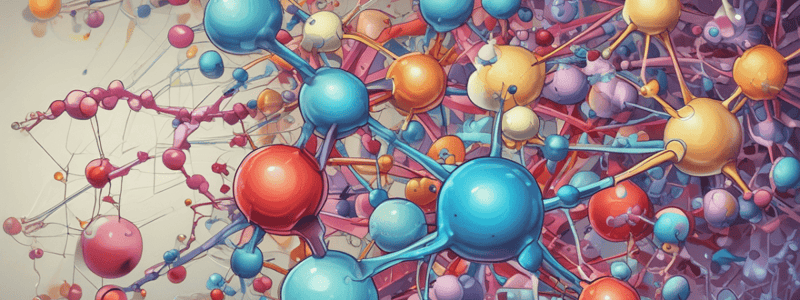Podcast
Questions and Answers
What is the primary function of protein molecules in the human body?
What is the primary function of protein molecules in the human body?
- To provide energy to the body
- To digest food
- To carry out structural and functional aspects (correct)
- To regulate body temperature
How many amino acids occur in nature?
How many amino acids occur in nature?
- 20
- 300 (correct)
- 100
- 50
What type of amino acids are most amino acids in the human body?
What type of amino acids are most amino acids in the human body?
- Delta amino acids
- Beta amino acids
- Gamma amino acids
- Alpha amino acids (correct)
What is the exception to alpha amino acids in the human body?
What is the exception to alpha amino acids in the human body?
How do the three-letter genetic codes provide information for protein synthesis?
How do the three-letter genetic codes provide information for protein synthesis?
What is the basis for the five ways of classifying amino acids?
What is the basis for the five ways of classifying amino acids?
What type of amino acids are Leucine and Lysine?
What type of amino acids are Leucine and Lysine?
What is the total number of amino acids found in the human body?
What is the total number of amino acids found in the human body?
Which of the following amino acids are required for normal growth and optimal health?
Which of the following amino acids are required for normal growth and optimal health?
What is the primary function of peptide bonds in proteins?
What is the primary function of peptide bonds in proteins?
What is the classification based on the nature or polarity of the side chain of amino acids?
What is the classification based on the nature or polarity of the side chain of amino acids?
What type of amino acid is Histidine?
What type of amino acid is Histidine?
What occurs if one essential amino acid is deficient in the diet?
What occurs if one essential amino acid is deficient in the diet?
Which of the following amino acids are not synthesized by the body?
Which of the following amino acids are not synthesized by the body?
What is the characteristic of amino acids with an asymmetric carbon atom?
What is the characteristic of amino acids with an asymmetric carbon atom?
How are amino acids classified based on their metabolism?
How are amino acids classified based on their metabolism?
Flashcards are hidden until you start studying
Study Notes
Amino Acids and Peptides
- Proteins are polymers of amino acids, and all proteins are composed of a number of amino acids linked by peptide bonds.
- Although there are around 300 amino acids in nature, only 20 of them are found in the human body, as three-letter genetic codes provide codons for only these 20 L-α-amino acids.
- Most amino acids (except proline) are alpha amino acids, meaning the amino group is attached to the same carbon atom as the carboxyl group.
Classification of Amino Acids
- Amino acids can be classified in five ways: based on chemical structure, metabolic product, nutritional requirement, nature or polarity of the side chain, and chemical nature of the amino acid in solutions.
- Classification based on chemical structure of the side chain:
- (no specific information provided)
- Classification based on metabolism:
- Ketogenic amino acids: yield either acetoacetate (one of the ketone bodies) or one of its precursors (e.g., Leucine and Lysine).
- Ketogenic and glucogenic amino acids: partially ketogenic and partially glucogenic.
- Glucogenic amino acids: yield pyruvate or one of the intermediates of the citric acid cycle (e.g., used for gluconeogenesis in the liver and kidney).
- Classification based on nutritional requirements:
- Essential amino acids: cannot be synthesized by human beings and must be obtained through food (e.g., Isoleucine, Leucine, Threonine, Lysine, Methionine, Valine, Phenylalanine, Tryptophan).
- Partially essential (semi-essential) amino acids: required for growing children, but not essential for adult individuals (e.g., Histidine and Arginine).
- Non-essential amino acids: can be synthesized by the body, and even if absent in the diet, the body can synthesize them (e.g., Alanine, Asparagine, Aspartic acid, Cysteine, Glutamine, Glutamic Acid, Glycine, Proline, Serine, and Tyrosine).
- Classification based on nature or polarity of the side chain:
- Hydrophilic (polar) amino acids
- Hydrophobic (nonpolar) amino acids
Optical Activity
- Amino acids having an asymmetric carbon atom have different groups attached to the same carbon atom, resulting in optical activity.
- (no additional information provided)
Studying That Suits You
Use AI to generate personalized quizzes and flashcards to suit your learning preferences.




